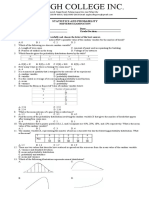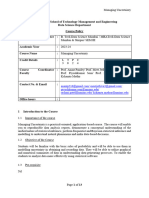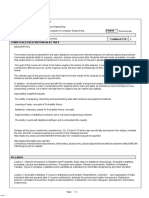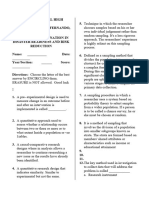0 ratings0% found this document useful (0 votes)
64 viewsMATHT13 Engineering Data Analysis
This 2-credit unit course introduces methods of data collection and analysis for engineering applications. It covers probability distributions, statistical inference techniques like estimation and hypothesis testing, experimental design, and simple linear regression. Students will learn to apply statistical methods to analyze data and design experiments involving multiple factors. Evaluation includes class participation, quizzes, attendance, and a final examination.
Uploaded by
Nechole Villaflores RogelioCopyright
© © All Rights Reserved
Available Formats
Download as DOCX, PDF, TXT or read online on Scribd
0 ratings0% found this document useful (0 votes)
64 viewsMATHT13 Engineering Data Analysis
This 2-credit unit course introduces methods of data collection and analysis for engineering applications. It covers probability distributions, statistical inference techniques like estimation and hypothesis testing, experimental design, and simple linear regression. Students will learn to apply statistical methods to analyze data and design experiments involving multiple factors. Evaluation includes class participation, quizzes, attendance, and a final examination.
Uploaded by
Nechole Villaflores RogelioCopyright
© © All Rights Reserved
Available Formats
Download as DOCX, PDF, TXT or read online on Scribd
You are on page 1/ 1
Title ENGINEERING DATA ANALYSIS
This course introduces different methods of data collection and the
suitability of using a particular method for a given situation. It includes
a coverage and discussion of the relationship of probability to
statistics, probability distributions of random variables and their uses,
linear functions of random variables within the context of their
application to data analysis and inference, estimation techniques for
Description
unknown parameters, and hypothesis testing used in making
inferences from sample to population, inference for regression
parameters and build models for estimating means and predicting
future values of key variables under study. Statistically based
experimental design techniques and analysis of outcomes of
experiments are discussed with the aid of statistical software.
Course Code MATHT13
Credit Units 2 units
Prerequisites
After completing this course, the students must be able to:
Course
Apply statistical methods in the analysis of data.
Outcomes
Design experiments involving several factors.
Obtaining Data
- Methods of Data collection in Quantitative and Qualitative
Research
- Planning and conducting surveys
Probability
- Sample space and relationships among events
- Rules of probability
Discrete probability distribution
- Random variables and their probability distributions
- Cumulative distribution functions
- The Binomial distribution
- The Poisson distribution
Course Outline
Continuous probability distribution
Joint probability distribution
- Two or random variables
- Linear functions of random variables
- General functions of random variables
Sampling distributions and Point estimation of parameters
Statistical Intervals
- Confidential Intervals
- Prediction Intervals
- Tolerance Intervals
Hypothesis Testing
Simple linear regression and correlation
• Class standing 20%
• Quizzes 30%
Course
• Attendance 10%
Evaluation
• Examination 40%
100%
• “Engineering Mechanics: Dynamics” by Ferdinand L. Singer.
Textbook
• “Dynamics of Particles and Rigid Bodies” by Anil V. Rao.
You might also like
- MTS-PST-311 Course Outline (BGEN3, BMEN3, and BMMP3) - 2024No ratings yetMTS-PST-311 Course Outline (BGEN3, BMEN3, and BMMP3) - 20248 pages
- Probability Theory and Stochastic Processes: Course Description and ObjectivesNo ratings yetProbability Theory and Stochastic Processes: Course Description and Objectives3 pages
- Probability and Statistics (MTS-PST-311) Module Details_080751No ratings yetProbability and Statistics (MTS-PST-311) Module Details_0807519 pages
- 1probability and Statistics For Pre-Engineers Course OutlineNo ratings yet1probability and Statistics For Pre-Engineers Course Outline3 pages
- Mumbai University - FYBSc - Syllabus - 4.60 Statistics PDF100% (1)Mumbai University - FYBSc - Syllabus - 4.60 Statistics PDF7 pages
- Course Outline Probability and StatisticsNo ratings yetCourse Outline Probability and Statistics4 pages
- Course Outline Title Probability and Statistics Code MT-205 Credit HoursNo ratings yetCourse Outline Title Probability and Statistics Code MT-205 Credit Hours7 pages
- Solutions Manual to accompany Applied Multivariate Statistical Analysis 6th edition 0131877151 pdf downloadNo ratings yetSolutions Manual to accompany Applied Multivariate Statistical Analysis 6th edition 0131877151 pdf download33 pages
- 4th Sem Detailed Syllabus (B. Sc. in Data Science)No ratings yet4th Sem Detailed Syllabus (B. Sc. in Data Science)5 pages
- Course Outline - Probability and Statistics For Engineers (ES 202)No ratings yetCourse Outline - Probability and Statistics For Engineers (ES 202)3 pages
- Solutions Manual to accompany Applied Multivariate Statistical Analysis 6th edition 0131877151 - 2025 Scribd Download Full Chapters100% (7)Solutions Manual to accompany Applied Multivariate Statistical Analysis 6th edition 0131877151 - 2025 Scribd Download Full Chapters30 pages
- 21MAB204T (Course Handout) 2024-25 (1) (1)No ratings yet21MAB204T (Course Handout) 2024-25 (1) (1)9 pages
- Statistical Methods and Testing of HypothesisNo ratings yetStatistical Methods and Testing of Hypothesis52 pages
- Nptel: Probability Methods in Civil Engineering - Video CourseNo ratings yetNptel: Probability Methods in Civil Engineering - Video Course2 pages
- Get Solutions Manual to accompany Applied Multivariate Statistical Analysis 6th edition 0131877151 free all chapters100% (6)Get Solutions Manual to accompany Applied Multivariate Statistical Analysis 6th edition 0131877151 free all chapters30 pages
- Course Name Statistical Analysis For Management Course Code GMB121No ratings yetCourse Name Statistical Analysis For Management Course Code GMB1213 pages
- BCA 3rd Sem TBC305(1) Probability and Statistcs RVKulkarni-FinalNo ratings yetBCA 3rd Sem TBC305(1) Probability and Statistcs RVKulkarni-Final2 pages
- Bmat202l Probability-And-Statistics TH 1.0 65 Bmat202lNo ratings yetBmat202l Probability-And-Statistics TH 1.0 65 Bmat202l3 pages
- Catalogue of Courses - StatisticsexistingNo ratings yetCatalogue of Courses - Statisticsexisting4 pages
- Machine Learning. Supervised Learning Techniques and Tools: Nonlinear Models Exercises with R, SAS, Stata, Eviews and SPSSFrom EverandMachine Learning. Supervised Learning Techniques and Tools: Nonlinear Models Exercises with R, SAS, Stata, Eviews and SPSSNo ratings yet
- Uji Akar Unit - Pendekatan Augmented Dickey-Fuller (ADF)No ratings yetUji Akar Unit - Pendekatan Augmented Dickey-Fuller (ADF)16 pages
- Cohen's Conventions For Small, Medium, and Large Effects: Difference Between Two MeansNo ratings yetCohen's Conventions For Small, Medium, and Large Effects: Difference Between Two Means2 pages
- IMPORTANT: You May Take This Question Paper Away at The End of TheNo ratings yetIMPORTANT: You May Take This Question Paper Away at The End of The10 pages
- Midterm Exam Subject: Economic Statistics (INS2004) : Prob 1No ratings yetMidterm Exam Subject: Economic Statistics (INS2004) : Prob 12 pages
- Econometrics 3A Supplementary Examination MemoNo ratings yetEconometrics 3A Supplementary Examination Memo9 pages
- SPSS Tutorial 2:: Gender Seen Batman AgeNo ratings yetSPSS Tutorial 2:: Gender Seen Batman Age4 pages
- Core - 11 - Statistics-and-Probability - q4 - CLAS1 - Hypothesis - Testing - v1.2 - JOSEPH AURELLONo ratings yetCore - 11 - Statistics-and-Probability - q4 - CLAS1 - Hypothesis - Testing - v1.2 - JOSEPH AURELLO12 pages
- Hypothesis Testing: Example 1: Does A New Drug Improve Cancer Survival Rates?No ratings yetHypothesis Testing: Example 1: Does A New Drug Improve Cancer Survival Rates?25 pages
- Tips and Tricks For Calculator Casio Fx-570MS83% (6)Tips and Tricks For Calculator Casio Fx-570MS8 pages
- Complete Answer Guide for Business Statistics in Practice 8th Edition Bowerman Solutions Manual100% (9)Complete Answer Guide for Business Statistics in Practice 8th Edition Bowerman Solutions Manual52 pages
- Advanced Econometrics:Test 1 (30 Marks) Date: October 9, 2017No ratings yetAdvanced Econometrics:Test 1 (30 Marks) Date: October 9, 20174 pages
- Confidence Interval Estimation (Basic Statistics)No ratings yetConfidence Interval Estimation (Basic Statistics)20 pages

























































































